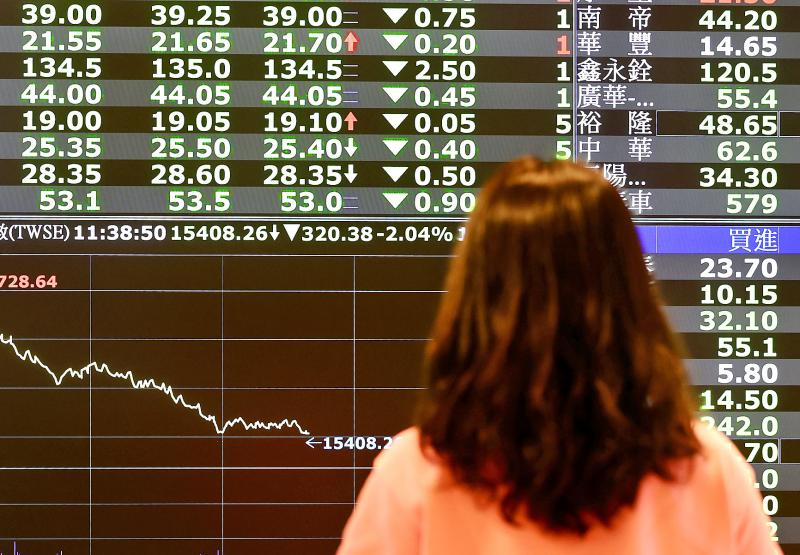The TAIEX took a beating yesterday, closing down 380 points and erasing all of Tuesday’s gains, as investors locked in the previous session’s profits from the bellwether electronics sector, dealers said.
Market sentiment remained cautious due to a rate hike cycle launched by the US Federal Reserve to fight inflation, so selling spread to old economy stocks, in particular the transportation sector, where several major shipping stocks are traded, pushing the main board even lower, dealers said.
Global stock markets and oil prices also hit the skids yesterday as worries about rising interest rates and recessions persisted.

Photo: CNA
The enthusiasm that saw Wall Street post its best day in more than a month on Tuesday suddenly evaporated as Europe opened 1.5 percent lower and Brent crude prices plunged 4 percent following what had also been a downbeat Asian session.
In Taipei yesterday, the TAIEX closed down 380.89 points, or 2.42 percent, at 15,347.75. Turnover totaled NT$278.532 billion (US$9.35 billion), with foreign institutional investors selling a net NT$22.44 billion of shares on the main board, Taiwan Stock Exchange data showed.
The sell-off wiped out the main board’s Tuesday gain of 361.06 points, or 2.35 percent.
Japan’s benchmark Nikkei 225 yesterday shed 0.4 percent to close at 26,149.55. Australia’s S&P/ASX 200 lost 0.2 percent to 6,508.50, South Korea’s KOSPI fell 2.7 percent to 2,342.81, Hong Kong’s Hang Seng dropped 2.6 percent to 21,008.34, while the Shanghai Composite index sank 1.2 percent to 3,267.20.
“Despite a rally on Tuesday, the [TAIEX] remained technically unstable after a recent slump, as market sentiment remained haunted by concerns over a rate hike by the Fed, which is expected to continue to drain funds out of the region for US dollar-denominated assets,” MasterLink Securities Corp (元富證券) analyst Tom Tang (湯忠謙) said. “There are growing concerns that an aggressive rate hike cycle will hurt the economy.”
Before Tuesday’s rebound, the TAIEX had tumbled about 1,300 points, or 7.82 percent, over the past eight trading sessions, meaning the main board was technically fragile, dealers said.
“In addition, investors witnessed Dow futures dipping again now, pointing to an ugly opening of the spot market later today, so they simply shifted to the sell side to take their money and run, avoiding possible losses tomorrow,” Tang said.
Fed Chairman Jerome Powell was yesterday due to start testifying at the US Congress. Investors would be looking for further clues about whether another 75 basis-point rate hike is on the cards for next month.
Economists polled by Reuters expect the Fed to deliver a 75-basis-point interest rate hike next month, followed by a 0.5 percentage-point rise in September.
They said the Fed is unlikely to scale back to 0.25 percentage-point rate hikes until November at the earliest.
Most other global central banks face a similar situation, apart from the Bank of Japan, which last week pledged to maintain its policy of ultra-low interest rates.
Minutes from the Bank of Japan’s April policy meeting released yesterday showed the central bank’s concerns about the impact the plummeting currency could have on the country’s business environment.

To many, Tatu City on the outskirts of Nairobi looks like a success. The first city entirely built by a private company to be operational in east Africa, with about 25,000 people living and working there, it accounts for about two-thirds of all foreign investment in Kenya. Its low-tax status has attracted more than 100 businesses including Heineken, coffee brand Dormans, and the biggest call-center and cold-chain transport firms in the region. However, to some local politicians, Tatu City has looked more like a target for extortion. A parade of governors have demanded land worth millions of dollars in exchange

Hong Kong authorities ramped up sales of the local dollar as the greenback’s slide threatened the foreign-exchange peg. The Hong Kong Monetary Authority (HKMA) sold a record HK$60.5 billion (US$7.8 billion) of the city’s currency, according to an alert sent on its Bloomberg page yesterday in Asia, after it tested the upper end of its trading band. That added to the HK$56.1 billion of sales versus the greenback since Friday. The rapid intervention signals efforts from the city’s authorities to limit the local currency’s moves within its HK$7.75 to HK$7.85 per US dollar trading band. Heavy sales of the local dollar by

Taiwan Semiconductor Manufacturing Co’s (TSMC, 台積電) revenue jumped 48 percent last month, underscoring how electronics firms scrambled to acquire essential components before global tariffs took effect. The main chipmaker for Apple Inc and Nvidia Corp reported monthly sales of NT$349.6 billion (US$11.6 billion). That compares with the average analysts’ estimate for a 38 percent rise in second-quarter revenue. US President Donald Trump’s trade war is prompting economists to retool GDP forecasts worldwide, casting doubt over the outlook for everything from iPhone demand to computing and datacenter construction. However, TSMC — a barometer for global tech spending given its central role in the

An Indonesian animated movie is smashing regional box office records and could be set for wider success as it prepares to open beyond the Southeast Asian archipelago’s silver screens. Jumbo — a film based on the adventures of main character, Don, a large orphaned Indonesian boy facing bullying at school — last month became the highest-grossing Southeast Asian animated film, raking in more than US$8 million. Released at the end of March to coincide with the Eid holidays after the Islamic fasting month of Ramadan, the movie has hit 8 million ticket sales, the third-highest in Indonesian cinema history, Film